It’s hard to be efficient at work when most of your time is spent memorizing the tasks that need to be done. But what if I tell you that there’s a method that allows you to think less and do more?
Well, I am talking about the Getting Things Done or GTD method, which is becoming more and more popular among working professionals with every passing day.
Although I have been following the GTD methodology for some time now, it only came to my mind recently that I should share it with you all.
And now you might be thinking, why now?
Actually, there are two reasons to discuss GTD methodology at this particular point in time. Firstly, I wanted to ascertain that this method can actually work for me. And honestly, it worked out pretty well.
Secondly, the 2020 global pandemic has made me rethink how much we all need to emphasize on smart work to keep mental stress at bay.
According to me, GTD methodology offers a great way to enhance your productivity while making sure that you don’t slip up managing your stress levels.
Want to manage your time and tasks precisely? Switch to ProofHub today!
Table of Contents
What is Getting Things Done or GTD Method?
Before we delve deeper to know how the Getting Things Done method works, let’s have a quick look at its simple definition.
In the simplest terms, Getting Things Done is a systematic process of organizing tasks in such a way that your focus is on completing tasks rather than just recalling them.
The basic idea of GTD is to make sure that you keep your brain free for work by having all your ideas, plans, and tasks noted somewhere that is easily accessible. As a result, instead of thinking about the tasks on your schedule, you direct all your efforts to take action and complete those tasks.
David Allen, who is the pioneer of the GTD, identifies it as a time management method to master the art of stress-free productivity.
Here’s what he says “Use your mind to think about things, rather than think of them. You want to be adding value as you think about projects and people, not simply reminding yourself they exist.”
The Stages of the GTD Method
The best thing about GTD is that it has been divided into 5 distinct stages, which makes it easy to implement in your professional life.
Often many people complain that the method isn’t working for them because it’s complicated. However, their claim is not completely true.
Actually, the GTD method is easy to learn, but the real challenge is to put the method into practice, especially for the first couple of times. But as you start using it more often, it will become easier for you to get along with it.
Keep in your mind that there’s no defined set of rules to make sure that the Getting Things Done method works for you. However, the best way to use this method to your advantage is by having a crystal clear understanding of all its 5 stages.
I have tried my best to define these stages in simple words as follows:
Capture
This stage is all about gathering ideas, plans, one-time & recurring tasks, and literally everything that is in your brain related to the work.
If you want to execute this stage in the simplest way, all you need is a pen and a notebook to jot down everything. Or, you can use a more advanced to-do app or a planning system for the same.
Just make sure that whatever tool you are using to capture your ideas is easily accessible so that you can quickly record whatever comes to your mind. Also, before proceeding to the next stage, just be certain that you have decluttered your head and put everything down into a format that is easy to understand.
Clarify
Now, you need to assess the feasibility of everything you’ve gotten out of your head in your sheet of paper or to-do list. You need to figure out whether it’s possible to work on a certain idea or not. In case it’s a yes, identify the steps you need to take for executing the idea.
It’s obvious that every idea that is getting out of your brain isn’t actionable, so you need to discard the ones that are unachievable.
Also, for ideas that are likely to take less time to complete, you should start working on them immediately. For tasks that demand significant time and effort, you need to put them on a task list and schedule them for later.
Organize
When you see that you have a lot of tasks on your to-do list, you just simply want to jump in and complete those tasks as soon as possible.
Honestly, there’s nothing bad about it. However, things are bound to get complex when you don’t prioritize tasks. Eventually, you will find yourself in a situation where missing deadlines become too frequent.
The agenda of this stage is to keep yourself in a better position by prioritizing tasks and putting them under different categories. By doing so, it will be much easier for you to complete the right tasks at the right time.
Organizing your project ideas and tasks is easier than ever with ProofHub. Try it for Free!
Reflect
After creating lists of all the tasks along with their actionable steps and priority levels, you need to review them. Reflection gives you the self-assurance you need to know that things are planned and you need to work on them one by one.
Each list will reflect the tasks that you need to do in a particular time period. It will become much easier for you to stay updated about the crucial activities that need your immediate attention.
Moreover, by reflecting on these task lists regularly, you can avoid missing deadlines and building huge piles of uncompleted tasks.
Engage
The final stage of the GTD simply prompts you to start doing the tasks that you have noted down on the list. As you have already figured out the tasks and the manageable steps to complete them, it’s time to engage.
When working on these tasks, don’t forget to tick completed tasks off the list because it will help you to feel accomplished and motivate you to do even better. Once you make this a habit, you are most likely to find yourself in a position where you achieve all your objectives with relative ease.
These were the 5 stages that you need to embrace if you want to adopt the Getting Things Done method. Now, let’s take a step forward to know about the best tools that can help you implement the Getting Things Done framework.
8 GTD Apps and Software That You Can Use
If you have ever made a search query for GTD tools, you might have noticed that there is a sea of options available and it’s hard to make a choice. To make the search and selection process painless for you, I have assembled the 8 most popular GTD apps and software that you can start using right away.
So, here goes the list:
1. ProofHub

ProofHub is among the leading software available for GTD and comes with an intuitive interface, which is easy-to-use. It is basically an all-in-one project management software that can help you manage several projects, tasks, and teams all at once. The best thing about ProofHub is that it offers you plenty of features that will not only help you to put the Getting Things Done method into effect but also let you organize multiple project workflows and collaborate effectively with your team.
The project management software offers 4 different views for your projects and tasks, namely List view, Kanban board view, Gantt chart view, and Calendar view. It’s easy to set priorities with start and due dates for tasks in each view format. The Kanban boards will make it much easier for you to manage tasks and see them moving through the different stages of a project workflow.
Additionally, ProofHub comes with a highly functional Notes feature that you can use to record everything important to your project. You have the flexibility to assign distinct colors to notes, subscribe teammates to them, and mark a note private to limit its access. Also, you can attach files, add comments, save multiple notes in notebooks, and access all your notes from a central place.
Best Features of ProofHub:
- Create tasks and divide them into smaller manageable subtasks
- Create custom roles for people in your team and delegate tasks easily
- Generate custom reports to see how you and your team are performing
- Built-in timer and timesheets to record time data and analyze how much time you spend working on each task
- Activity logs to keep an eye on all the project and task activities
- Easy file and document sharing to bring everything together
App Available For: Android | iOS | Web browser
Pricing:A free trial is available for new users. For information on our pricing plans, kindly visit our pricing page.
Want to see how ProofHub can be your perfect GTD tool? Sign up for Free now!
2. Nirvana
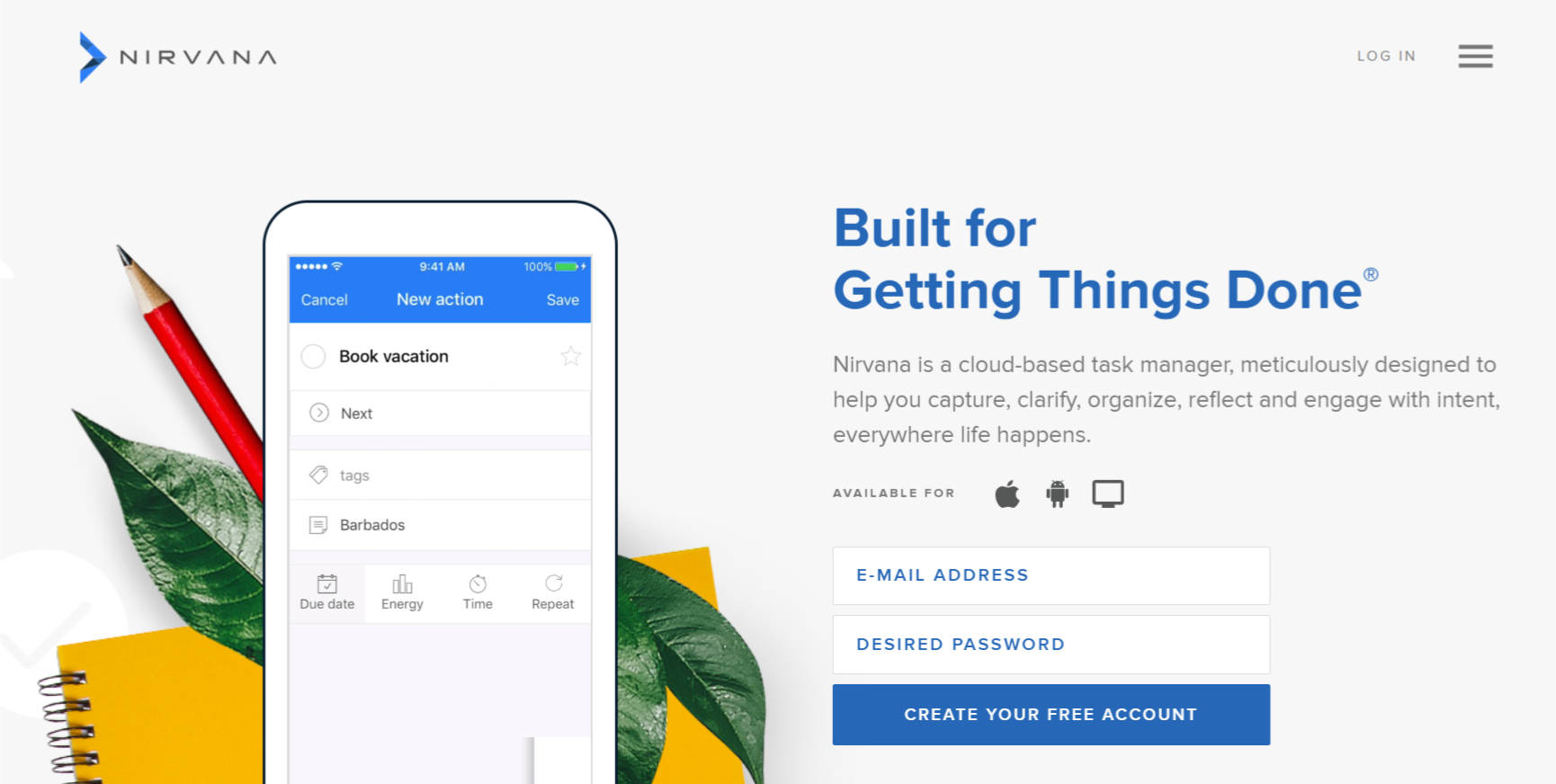
Task management is the key to implement the GTD method and the Nirvana app can help you with that. It is a cloud-based task management app that is meticulously designed to help you with different stages of the Getting Things Done framework.
The app allows you to label tasks in 4 different categories – next, waiting, scheduled, and someday. Also, you can easily set the due date for each task by selecting a date on the calendar.
Best Features:
- Set time and energy level estimate for each task
- Add tags to divide tasks and access them easily
- Attach notes with tasks
- Mark tasks for immediate action or defers them for a later time
App Available For: Android | iOS | Web browser
Pricing: Standard plan costs $5 per month (single user)
3. Todoist
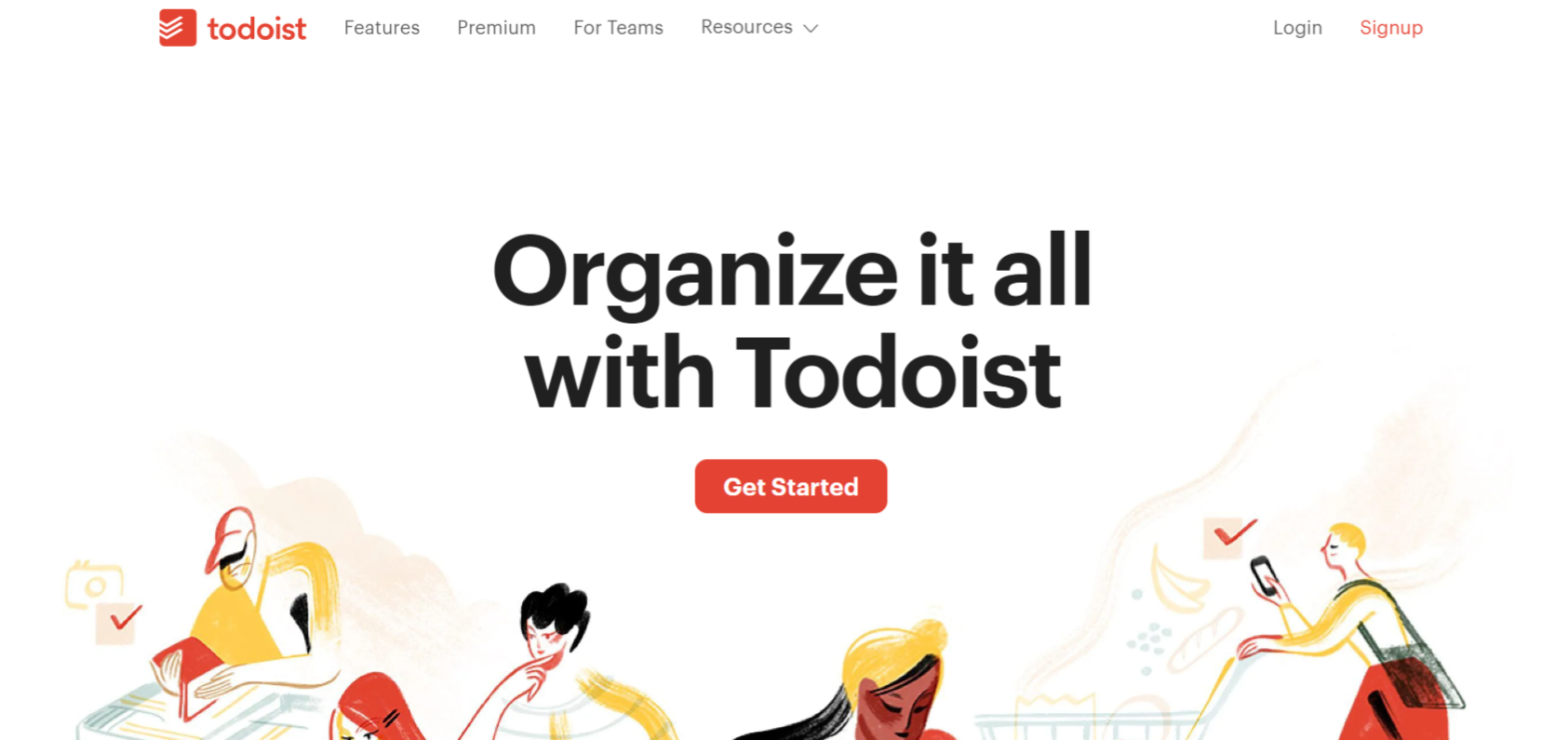
Another tool that is loaded with many essential GTD features is the Todoist app. It has a simple user interface that you can easily use to transfer ideas from your head onto a to-do list.
The app enables you to create multiple task lists to hold and organize all your work with relative ease. Additionally, you can create recurring tasks and set priorities to make sure that all the important work gets done on time.
Best Features:
- Access the details of each task with the task view mode
- Create subtasks to organize tasks better
- Delegate tasks to other people
- Notifications for comment posting, task completion and more
App Available For: Android | iOS | Web browser
Pricing: Business plan costs $5 per user per month
Also Read: Todoist Alternatives: 13 Best Solutions Offered by Competitors
4. Evernote
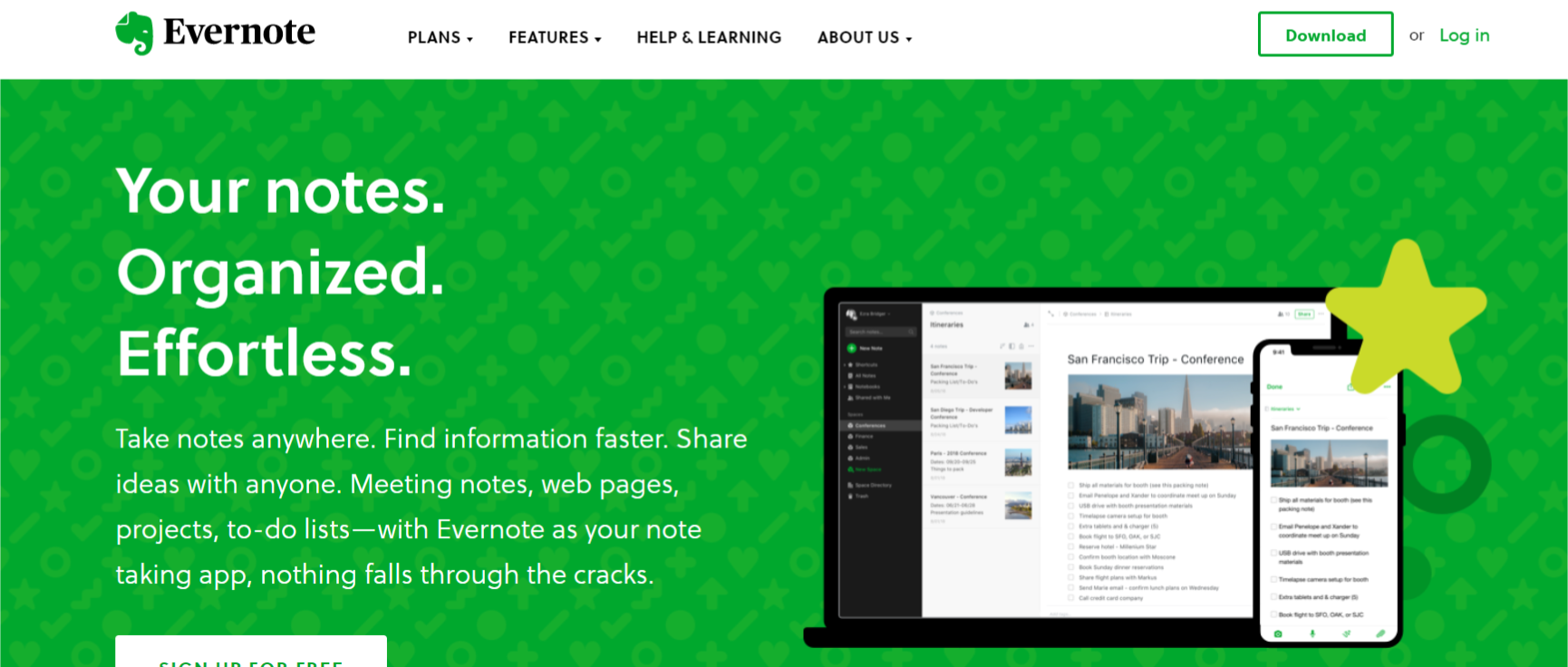
Evernote is among the most popular note-taking apps and is suitable to use for someone trying to bring GTD methodology to their work life. The app allows you to capture ideas and store them in its built-in notes. Whether it’s an official project or a personal event, this note-taking app makes sure that you never lose track of your anything.
One of the interesting abilities of Evernote is that you can use it to clip web pages so that you can easily revisit them wherever required. With this app, you get a single place for all your notes, ideas, and lists.
Best Features:
- Add attachments and record memos
- Set reminders for tasks and edit task documents
- Create checklists and cross off completed tasks
App Available For: Android | iOS | Web browser | Windows
Pricing: Business plan costs $14.99 per user per month (min. 2 users)
Further Reading: Evernote Alternatives: 12 Note-Taking Apps You Should Be Using Today
5. Trello

Trello is a collaboration tool that offers in-built notes and task management features that you can count on. It comes with boards, lists, and cards that will make it convenient for you to organize and prioritize tasks.
The virtual notes offered by Trello are great for documenting your ideas and inspirations. Moreover, you can immediately create lists and add tasks that you need to accomplish. You will also find Trello labels to be extremely useful for prioritizing your tasks and stay ahead of the deadlines.
Best Features:
- Add tags and comments to task cards
- Upload and attach files with tasks
- Assign tasks to individuals and groups
App Available For: Android | iOS | Web browser | Windows
Pricing: The enterprise plan costs $20.83 per user per month
Also Read: Top 17 Trello Alternatives: List of Project Management & Kanban Software
6. Remember the Milk
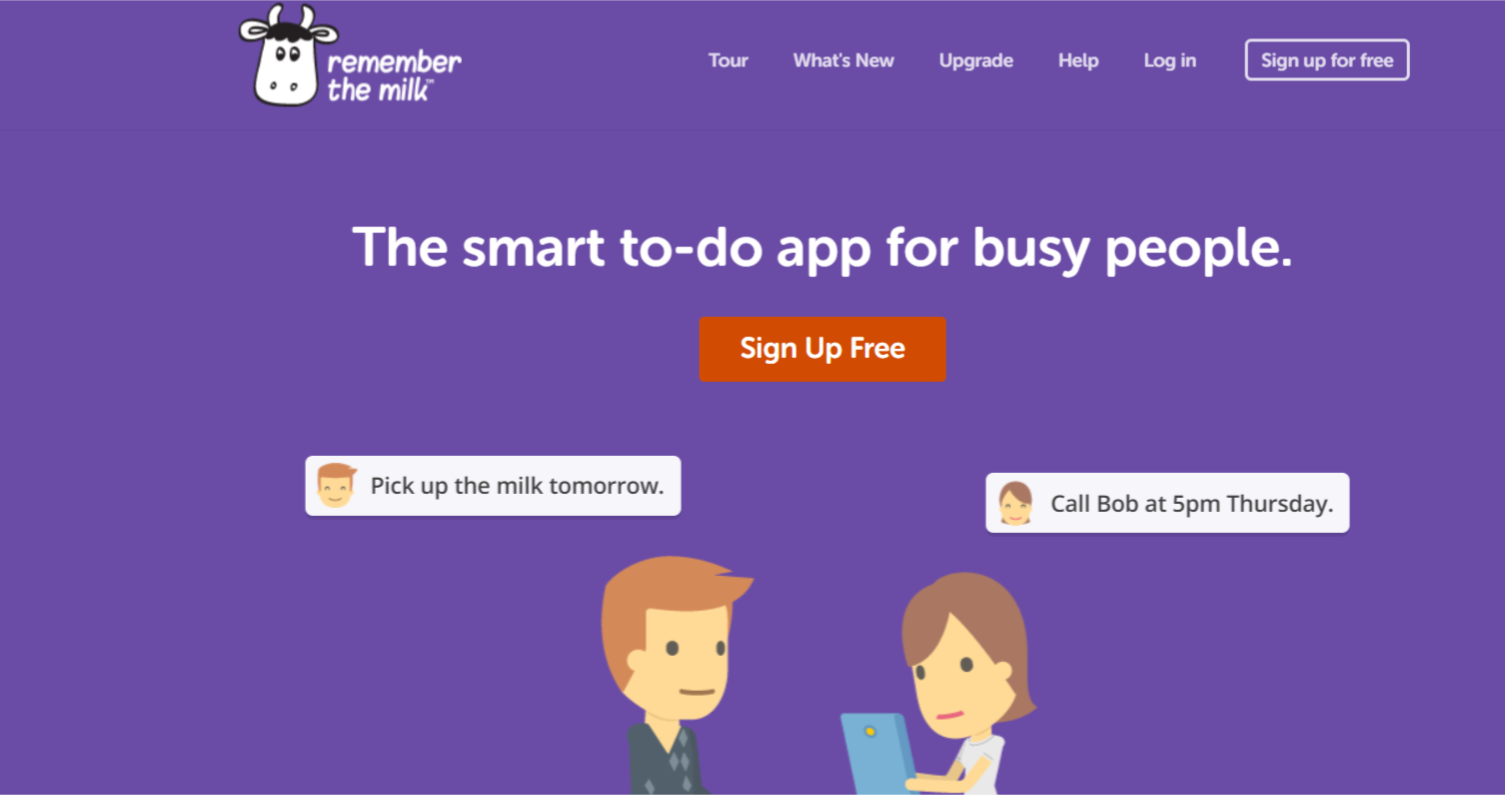
Remember the Milk is a to-do list app that is very much aligned with the process of GTD. The name of the app is somewhat peculiar, but its functionality is on target when it comes to managing your everyday tasks.
With the help of this app, you can simply stop thinking about your to-dos, because it is going to remember your tasks. You can add new tasks in a flash and even assign task properties such as due date, priority level, tags, and much more
Best Features:
- Break a task into several small subtasks
- Attach files and documents with tasks
- Search tasks and set different parameters for the search
App Available For: Android | iOS | Web browser | Windows | Mac | Linux
Pricing: Pro Plan costs $39.99 per user per year
7. Ayoa
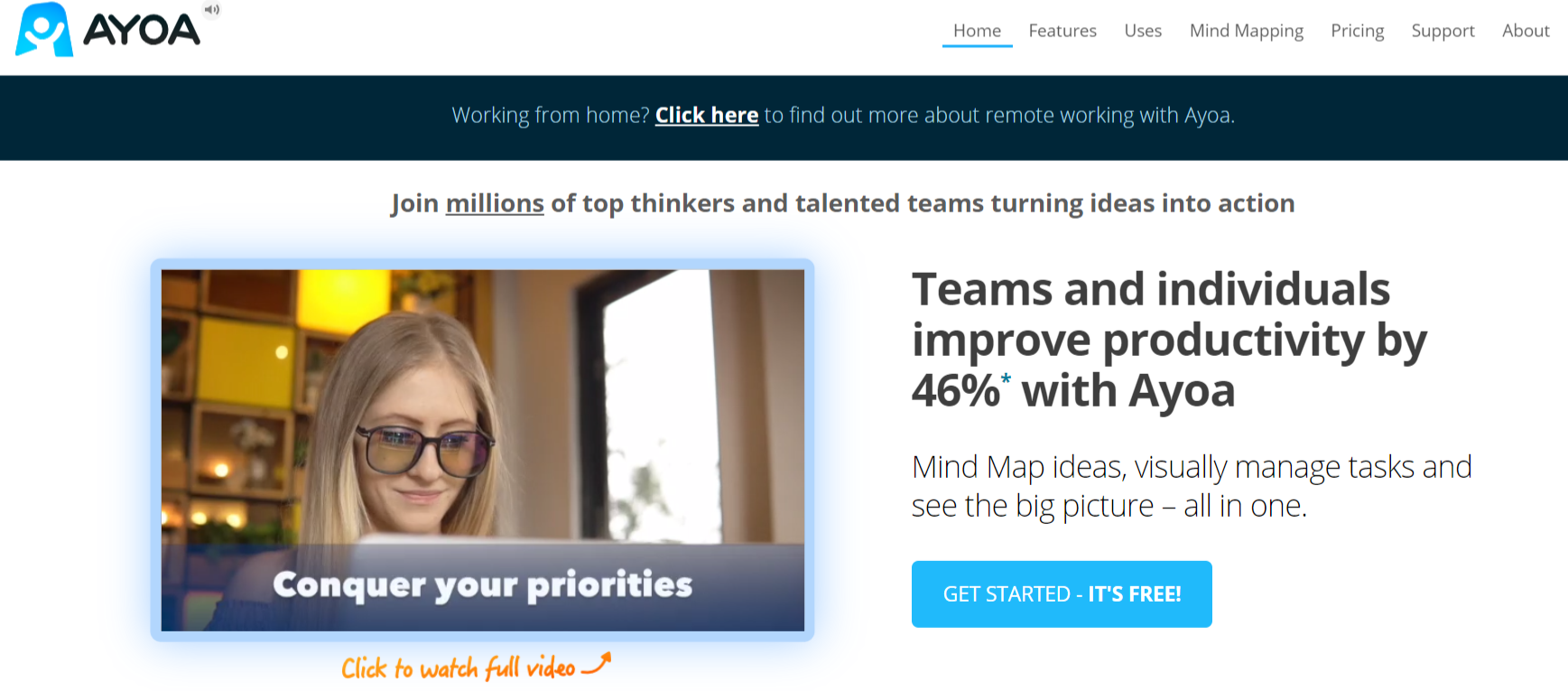
Ayoa is a task management software that allows you to manage tasks in a simple and effective way. You can capture all your ideas and store them in a safe place.
Its in-built planner allows you to stay on top of your workload and take actions to complete your pending tasks immediately. Also, you can schedule your tasks for now, next, or soon and make sure you do not miss deadlines.
Best Features:
- Integrated visual thinking tool capture information and ideas
- Add details for each task
- Create checklists and set due dates
App Available For: Android | iOS | Web browser | Windows | Mac |
Pricing: Advanced plan costs $10 per user month
8. nTask
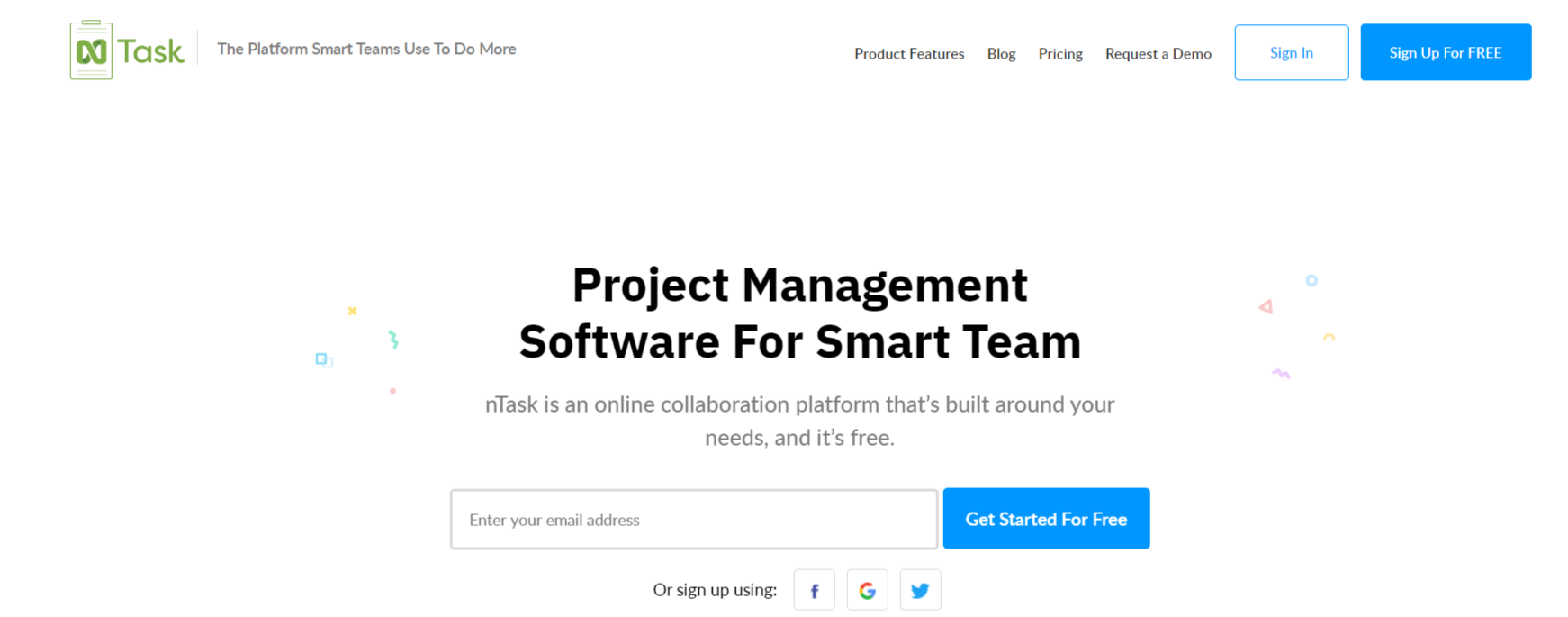
nTask is yet another app that works well with the Getting Things Done model. The app has a user-friendly interface and comes with several handy features. You can create multiple checklists and add several tasks to each checklist.
The task management app has made it simple to create tasks and subtasks so that you have a better view of what lies ahead of you. Moreover, you can schedule tasks, define priority levels, and assign them to different team members.
Best Features:
- Set start and end dates for a task
- Define the role of each team member
- Task reminders and in-app notifications
App Available For: Android | iOS | Web browser
Pricing: Business plan costs $7.99 per user per month
Want to make sure that the Getting Things Done method works for you and your team? Give ProofHub a try!
Conclusion
Getting Things Done is a simple methodology to start accomplishing more, no matter what field you are working in. By simply understanding the underlying philosophy of clearing your mind, and bringing into practice the 5 stages that I discussed, you can eventually become a master at it. Not to forget the tools that I shared with you can make it all the more easy. If you have been looking for ways to become more productive and get more things done, start practicing the Getting Things Methodology today.
All the best!
